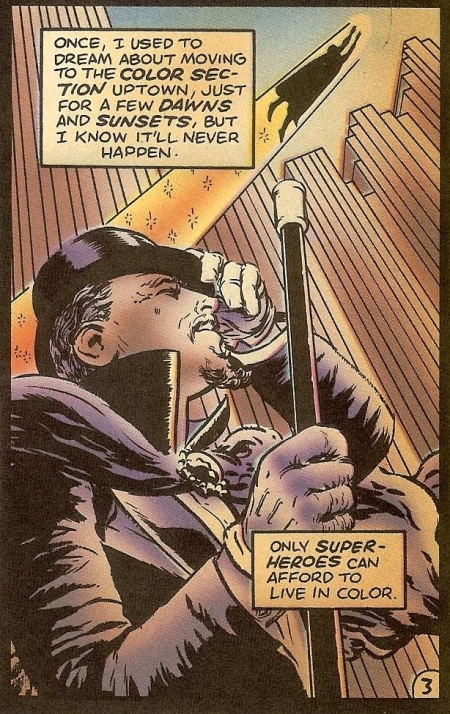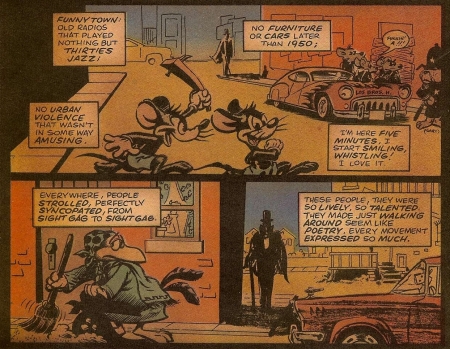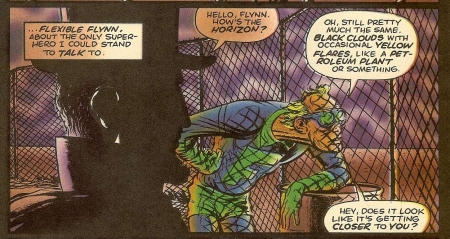I kind of chanced upon a very cool story by Alan Moore, one of my favorite comic book writers. I’d half-forgotten about In Pictopia! which appears in Anything Goes No. 2, published by Fantagraphics in December 1986. Anything Goes was a short-lived benefit book that Fantagraphics published to raise money for legal expenses.
I wrote a bit about my Alan Moore fan status earlier here. Alan Moore wrote and Donald Simpson did the artwork. The coloring, done by Eric Vincent, is actually very innovative – at various points he shifts from black and white to faded newsprint tones to full high-key comic book color.
In Pictopia! is a very self-conscious story about the evolution and de-evolution of comics – from newspaper funnies to various comic book genres. Like Moore’s later League of Extraordinary Gentlemen, there are gobs of references – from obvious to obscure. I found allusions to Winsor McCay, Blondie, Plastic Man, the Phantom, Alley Oop, Dick Tracy, and the Yellow Kid… and those are just the most obvious references. There’s quite a bit of Alan Moore annotations available on the web, but I didn’t see any for this story. Anyone out there want to host some sort of Alan Moore annotation wiki? I would contribute.
The other thing that the story is filled with are grids – mainly in the form of chain-link fences and skyscraper windows. These grids are composed of individual squares and rectangles that allude to the panel as the fundamental unit of comics.
The lead character is Nocturno the Necromancer – a black and white funnies magician, who appears to be based on Mandrake the Magician. Nocturno lives in the bleak Prince Feautures tenement and envies the superheros who “can afford to live in color.”
Nocturno’s neighbor Red (based on Blondie) has turned to prostitution while her husband, Deadwood, is away “drying out.”
Moore refers to various black and white comics neighborhoods – the Romance Quarter, and here’s a look at Funnytown:
Nocturno’s best friend and drinking buddy is a Flexible Flynn, based on Plastic-Man.
Flynn stares out toward the mysterious black horizon, which could represent a few different things: the edge of the comic panel, the edge of the page, and/or the oblivion of when a comic series is canceled and begins to be forgotten.
Over drinks, Flynn tells Nocturno:
Somethin’s goin’ on y’know? In this city! People are vanishing! — people are being replaced.
Nocturno tools around, running into gangs of garishly-colored new super-heros… and soon thereafter Flexible Flynn himself is replaced:
This replacement refers to a very common re-tooling done in comics. Over time characters are re-designed. The 1940s simpler detective Batman gives way to the 1950s goofier Batman, who is subsequently reinvented as the stark brutal noir Batman of the 1970s. Green Lantern, the Flash, Captain America and many more 1940s era comic heroes are revamped during the superhero comics flourishing of the 1960s. The 1960s Uncanny X-men fall into obscurity and are canceled around 1970; then they’re re-tooled in 1975 as the All-New X-men. There are hundreds of other examples, major and minor. Some of these changes are for the better, some worse. Often the revisions are more keeping up with popular fashion than substantive.
Alan Moore himself is responsible for brilliantly rebooting Swamp Thing from 70s atmospheric horror muck-monster to 80s sophisticated suspense.
In the late 1990s Moore will return this comic book trend; he spoofs these revisions with Supreme, his Superman stand-in. In “The Double Exposure Doom!” Moore invents (perhaps retcons) a whole limbo dimension where former versions of Supreme dwell. I like Moore’s clever commentary from an older Supreme referring to the new Supreme:
He looks like a ‘nineties model. His powers may be so poorly defined as to be virtually limitless! Treat him with caution…
Back to In Pictopia!: The last dialog spoken to Nocturno by a construction worker demolishing Funnytown:
People? There weren’t no people livin’ out here. Just some stray dogs and stuff. They’ve been painlessly destroyed.
Take my advice, buddy, an’ keep out of it. This city’s changing, and some things just don’t fit the continuity no more.
In Pictopia! is a metaphor for gentrification and for the abandoning of culture and tradition… but it’s mostly Moore’s reverential valentine to the confidence, craft and indeosyncrasies of early to mid-20th Century comics.
As in so much of Moore’s work, he’s working from familiar cloth. His readers have grown up reading comics, so Moore is able to riff off of the characters, the continuities, the cliches we know. Doing this, I think Moore taps into some archetypal power they have for us – though perhaps the power is more remembered than actual. Re-reading old comics can be like returning to one’s hometown school and thinking “this used to be bigger.” As I’ve been rereading the comic books I grew up collecting, I find myself wondering “how was I so into these? They seem rather infantile and formulaic.”
Nonetheless, Moore uses the familiar shapes to fashion a fresh new collage. Though he follows the familiar contours, he does it from a broader sort of meta- viewpoint. He’s brilliant at this synthesis… and with it, he’s breathed fresh life into many a tired comic stereotype.
Tags: Alan_Moore, comics, Donald_Simpson, In_Pictopia






27 September 2011 at 3:18pm |
This is really some beautiful stuff. I’ve not read *In Pictopia!*, but it seems like the gentrification angle sits so neatly along the tropes you write about that maybe it’s not such a minimal point.
21 March 2021 at 7:43pm |
The funny animals were penciled by Mike Kazaleh and the bar scene classic comic strip characters were penciled by Pete Poplaski; the rest was penciled and everything inked by that mush-head, Don Simpson, fyi. — Don Simpson.